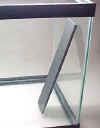|
Add Us To Your Favorites
| E-mail
Nathan


The
Spawning Process and Tank Set Up
Angelfish will spawn on just about anything as discussed
earlier. The ideal place for them to spawn on is a piece
of slate or a broad leafed plant such as an Amazon
Sword. If you plan on artificially hatching the eggs,
the slate is the best way to accomplish this. Simply
tilt the slate against the tank wall away from any heavy
current at an almost vertical position. Below is a picture of a
breeding slate provided by Steve Rybicki of Angels
Plus.

Angels will generally spawn every 7 to 14
days under ideal conditions. A female can lay from 200
to as much as 800 eggs or more at a time. The pair
should have their own 20 gallon tank or larger with no
other tank mates. The tank should be bare bottom meaning
no gravel in the tank. Eggs, wigglers, and/or free
swimming fry can get trapped in the gravel and die. This
also makes the tank much easier to clean. Ideal
temperatures for spawning is 82º to 84º F. Ph, Kh, and
Gh are not very important. The key is that they remain consistent
and not fluctuate rapidly. Ammonia, Nitrate, and Nitrite
should be at an absolute minimum. To accomplish this, I
do daily water changes to remove any uneaten food or
debris from the tank and a larger (about 40% to 50%)
water change once a week. Sponge filters are the choice
of filtration with Angels. They are great for biological
and mechanical filtration and are easily cleaned. They
also do not create a lot of current. Angels don't like
very strong currents. If you choose to use a
hang-on-back type filter be sure to use one a little undersized
for the tank as too not create too much current. Below is a picture of a typical
breeders sponge filter courtesy of Steve Rybicki.

Once a pair has formed they will begin cleaning a location
they have chosen to spawn on up to 3 days prior to them
spawning. Occasionally, they will lip lock and appear aggressive
towards each other as well. This is normal behavior.
They are seeing if their mate is strong, healthy, and
suitable enough to mate with. Not all pairs do this but
it does happen from time to time.
Just
prior to them spawning, the Angels papilla will appear.
The female will make several passes at the slate as to entice
the male. After a few passes, she will begin laying eggs
on the slate. The male will follow her, touching his
papilla on the eggs fertilizing them. This can go on for
several hours and is great to observe. This is also the best
time to confirm their true sexes. Be cautious when
observing them, if they are disturbed at all they may
eat the eggs. It's best they are left alone without a
lot of noise or traffic around the tank. Take a quick
peak and then observe them from a distance. Here's a few
pictures of a pair spawning. The Gold is a female and
the Gold Marble is a male. If you look hard you can see
the eggs near the top of the slate.



Parent
Raising
Parent raising fry isn't difficult at all. The hard part
is leaving them alone and letting the parents raise
their babies. This may take several attempts before they
get it right. Some Angels never raise their own spawns
and will eat every spawn that they lay. Some pairs
parent raise their very first batch. (I've only been
lucky enough to have this happen once.) It's best to
give them 15 to 20 tries before giving up on parent
raising. I will explain how to artificially raise the
spawn in the next segment.
After
48 hours the spawn will begin to hatch. If you look
closely you will see little tails wiggling all over. At
that point they are called "wigglers."
During this stage the fry have a spot on their head that
is sticky and they will stick to just about anything.
The parents will try and keep them in one spot and will
move them around the tank several times. Occasionally they will
mouth the wigglers to clean them off and move them where
they want by spitting them back out. Five days after
they begin wiggling they will become free swimming. It's
at this point (free swimming) you will want to start
feeding the fry. Not while they are wiggling. You will
need to feed them Baby Brine Shrimp. It's best you
start hatching Baby Brine Shrimp 24 hours before the
wigglers become free swimming. I will explain how to do
this later in this article.
<<<
Previous Page | Next
Page >>>

 



|

